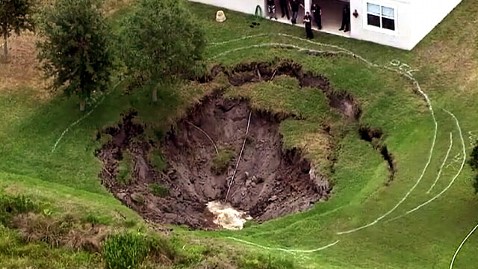The Science of Sinkholes: Are You at Risk?

Sinkhole that appeared May 3, 2012 in Windermere, Fla. Image: ABC News
The Lambro family of Windermere, Florida woke Thursday morning to a massive sinkhole in their backyard, forcing them to evacuate their home for fear that it would be sucked in by the gaping hole.
So what exactly is a sinkhole, and what caused it to appear suddenly in this quiet Florida neighborhood?
"A sinkhole is basically a closed depression that forms in the ground," said David Weary, a research geologist with the U.S. Geological Survey. "The simple explanation is that the ground surface falls into a void."
But what causes that void? Weary says there a both natural and man-made triggers.
"Usually you get a collapse because something occurred that transported the material, creating the void that the sinkhole falls into," Weary said. "If there's a cave underground filled with soil and sediment and you get an episode of high rainfall or a change in groundwater flow, the dirt that filled the void will be hollowed. Once it hollows out close to the ground surface, it becomes thin enough that it can't support what is on top of it and it falls in."
It is often a man-made structure that causes the change in groundwater flow and leads to a collapse.
In 2010, an entire three-story apartment building was sucked in by an enormous sinkhole. That case was what Weary called a "man-caused sinkhole."
"There was actually a big sewer line that's way deep down in the ground and it's leaking. So you can actually see there was a series of sinkholes that collapsed all along that sewer line."
Some areas are more prone to natural sinkholes than others.
"Karst terrain is a type of landscape that is characterized by having natural caves and springs and underwater groundwater flow," Weary said. "And almost all of Florida is classified as karst terrain," Weary said.
According the Weary, other areas in the U.S. that are prone to sinkholes include parts of Pennsylvania and Kentucky - but most sinkholes are concentrated in Florida because of the karst landscape.
But sinkholes are becoming more common in areas not thought of as at risk.
"In nature, sinkholes collapse fairly rarely but it seems to happen more and more in developed areas because people redirect storm water and it sets them off."
Weary said it's hard to know whether the recent Florida sinkhole was naturally occurring or caused by human activity, because Florida is so predisposed to sinkholes.
"It could have been anything from them directing rain runoff in some funny place to it being a leaky water pipe or a storm sewer. Or it could have been natural and they just happened to build a house on top of a covered, hidden sinkhole," Weary said.
If you see a sinkhole, he said, stay far away.
"Don't get near the edge because commonly, the void underneath it is bell-shaped so it's really unsafe to be anywhere near the edge in case it continues to collapse."